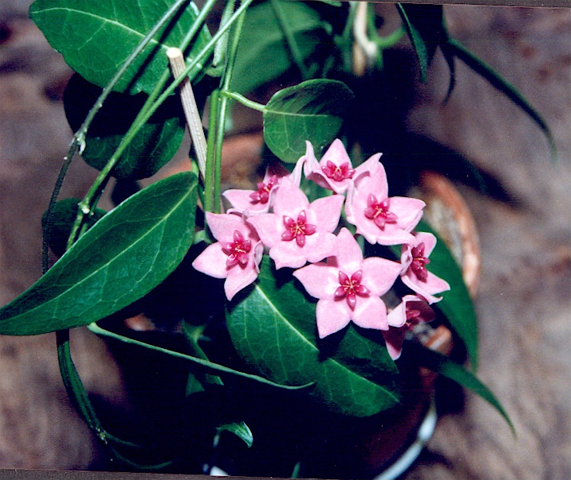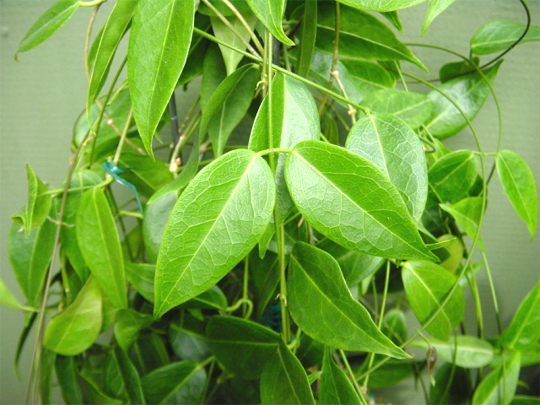
Hoya dennisii P. I. Forster et D. J. Liddle 1993
Type Description:
In Austrobalia 4(1) (1993) 51-52. P. I. Forster & D. Liddle. Hoya dennisii P. I. Forster et D. J. Liddle, sp. nov. affinis H. chloranthae Rech. a qua venis secondariis laminae folia 3 vel 4 vix manifestis, floribus minoribus (16‑17 mm in diametro), lobis coronae longioribus (circa 7 mm longis), et lobis coronae staminalis majoribus margins exteriore corollam excedentibus et apice lobis obtuso producto differt. Typus: Solomon Islands, Guadalcanal Province: Kwalo Range, Mt. Gallego, eastern ridge, 7 July 1965, T.C. Whitmore R.S.S. 6073 (halo: L!; iso: A!, BSIP!, K!, LAE!).
Epiphytic coriaceous liane to several meters; latex white. Stems cylindrical, wiry, with sparse trichomes, becoming glabrous with age, internodes up to 100 mm long and 1 mm diameter. Leaves petiolate; lamina lanceolate‑ovate, coriaceous, up to 72 mm long and 30 mm wide, discolorous, glabrous, venation obscure; upper surface dark green lower surface pale green; tip acuminate; base rounded to cordate petiole 5‑7 mm long and c. 0.8 mm diameter, with scattered trichomes colleters 2, at lamina base. Cyme racemiform, up to 100 mm long peduncle up to 85 mm long and 0.5 mm diameter, glabrous or with scattered trichomes, bracts ovate 0.5‑0.6 mm long, 0.4‑0.5 mm wide glabrous. Flowers 2‑3 mm long, 16‑17 mm diameter; pedicels 30‑35 mm long, c. 0.6 mm diameter, glabrous Sepals lanceolate, c. 1.2 mm long and 0.6 mm wide, glabrous. Corolla flattened campanulate, crimson‑pink externally glabrous, internally with short dense white trichomes, tube c. 5 mm long and 10 mm diameter, lobes triangular, c. 7 mm long and 7 mm wide. Staminal corona purple, c. 1.8 m long and 4.5 mm diameter inserted on column ± flush with corolla; lobes c. 3.2 mm long, 1.8 mm wide and 1.8 mm high, outer edge rounded and somewhat drawn out into lip not higher than the style‑head inner edge acute. Staminal column c. 2 mm long and 2.5 mm diameter; anther appendages lanceolate, c. 0.8 n long and 0.5 mm wide; alar fissure 3‑1.1 mm long. Style‑head pressed‑globose, c. 0.8 mm meter. Pollinaria c. 0.55 mm long and 0.46 mm wide; pollinia oblong, c. 6 mm long and 0.18 mm wide, with pellucid germination mouth on outer edge; corpusculum oblong-ovate, c. 14 mm long and 0.09 mm wide. Fruit and seed not seen.
Specimens examined: Solomon Islands. Guadalcanal Province: near Gold Ridge Village, 9°35'S, 160°07'E, Jun 1991, Forster 8714 & Liddle (BRI); Summit Mt. Gallego, NW Guadalcanal Rep 1966, Dennis BSIP4630 (BSIP), Popomanasia, Oct 1965, Corner 156 (K).
Distribution and habitat:H. dennisii has been collected only on Guadalcanal where it grows in montane and submontane situations from 650 to 1200 m altitude, usually as an epiphyte in bryophyte mats in rainforest.
Notes:H. dennisii belongs to a group of small, wiry stemmed, coriaceous to herbaceous leafed hoyas that occur in upper montane areas in Papuasia and Melanesia. The group includes H. venusta Schltr. in New Guinea and H. chlorantha Rech. in Samoa. H. dennisii is probably most closely related to H. chlorantha but differs from that species in the just visible 3 or 4 secondary veins in the leaf lamina, the smaller flowers 16‑17 mm in diameter with longer corolla lobes c. 7 mm long and the larger staminal corona lobes in which the outer edge; raised above the corolla and drawn out into a blunt lip.

Entomology: It gives us much pleasure to name this new species for Geoff Dennis of Honiara, Guadalcanal former Government Botanist and long‑time resident in the Solomon Lands, a plantsman of high repute with a garden of tropical delights. Geoff has been responsible for introducing many of the Hoyas from the Solomon Islands into general cultivation.
Translation of Latin: with an affinity to Hoya chlorantha Rechinger, 3 or 4 veins are barely visible from the secondary veins of the leaf blade, flowers small (16 to 17 mm in diameter) and the lobes of the staminal corona are large with the apex of the lobes exceeding the outside margins of the corolla and the apex of the lobes obtuse and different.

Photo by Ann Wayman, Central Point, OR.

